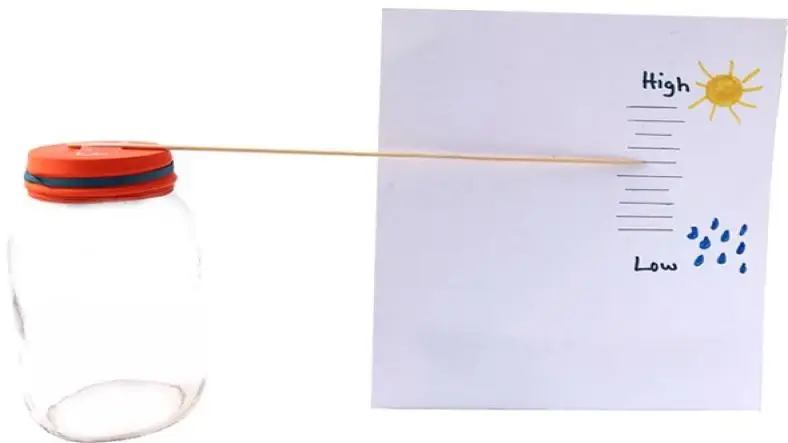Teaching children about weather and atmospheric science becomes much more exciting when they can see real changes happening in front of them. A barometer is one of the most important tools used in weather forecasting, and creating a homemade version gives children a hands-on way to understand air pressure and how it affects the weather.
This simple barometer experiment uses everyday materials and clearly demonstrates how atmospheric pressure works. The activity is ideal for school projects, DIY science days, homeschooling activities, or weekend learning sessions at home.
What Is a Barometer and Why Is It Important?
A barometer is a scientific instrument used to measure atmospheric pressure, which is the weight of the air pressing down on the Earth. Meteorologists use barometers to:
- Predict rain and storms
- Track changes in weather
- Understand patterns in the atmosphere
- Study climate and seasonal variations
When air pressure falls, it usually means rainy or stormy weather is coming. When air pressure rises, clear skies are more likely. By building this simple experiment at home, children get to see these changes happening in real time.
Why This Experiment Works for Kids
Children learn best when they see science in action. This DIY barometer:
- Uses simple materials
- Demonstrates clear cause-and-effect
- Shows visible movement when pressure changes
- Helps kids understand weather and air pressure
- Encourages curiosity, observation, and scientific thinking
It is also safe, affordable, and easy enough for children to do with minimal supervision.
Materials Needed
To build this homemade barometer, gather the following items:
- Glass jar or clear plastic bottle
- Balloon (latex, standard size)
- Drinking straw (lightweight plastic straw works best)
- Rubber band
- Scissors
- Tape
- Index card or small sheet of paper
- Marker
All items are easily available at home or in a local stationery store.
Step-By-Step Procedure to Build a Homemade Barometer
1. Prepare the Balloon
Start by cutting off the neck of the balloon. You need a flat, stretchy membrane that will sit on top of the jar. Stretching the balloon a few times makes it easier to pull tightly across the jar’s opening.
2. Seal the Jar with the Balloon
Place the cut balloon over the opening of the jar. Pull it tight so that it becomes a smooth, flat surface with no wrinkles.
Secure it firmly with a rubber band wrapped around the rim of the jar.
A tight seal is crucial because it prevents air from entering or escaping, which ensures accurate readings.
3. Attach the Straw
Take the drinking straw and tape one end to the center of the stretched balloon.
Make sure:
- The straw lies horizontally
- The taped part sits in the middle of the balloon
- The free end of the straw extends out over the edge of the jar
This straw acts as a pointer that moves up or down depending on the air pressure.
4. Create a Measurement Scale
Place an index card or a small piece of paper vertically behind the free end of the straw.
Use a marker to draw a simple scale with reference lines where the straw points.
Label the card with:
- Low pressure
- Medium pressure
- High pressure
Over time, you can mark more accurate reference lines based on observations.
5. Set Up the Barometer for Observation
Place the barometer in a location where it will not be disturbed by fans, direct wind, or frequent movement. Let it settle for a few hours to establish a baseline straw position.
Children can observe the straw daily and compare its movement with weather changes.
How the Homemade Barometer Works: Scientific Explanation
The balloon acts as a flexible membrane. When atmospheric pressure around the jar changes, it affects the balloon, which in turn moves the straw.
1. When air pressure rises
Higher pressure pushes down on the balloon, making it sink slightly.
This downward movement lifts the free end of the straw.
2. When air pressure drops
Lower pressure allows the balloon to expand outward.
This upward movement causes the straw’s free end to drop.
This simple upward or downward movement clearly indicates the changes in air pressure around the jar.
Google Ad 1
What Children Can Observe and Learn
This experiment teaches children several scientific concepts:
1. Air Has Weight
Atmospheric pressure exists because air has mass. Children often believe air is “empty,” but this experiment shows its effect on objects.
2. Pressure Changes Lead to Weather Changes
Children can compare the barometer’s readings with the actual weather outside.
- If the straw rises → high pressure → clear weather
- If the straw drops → low pressure → rain or storm approaching
3. Elasticity and Membranes
The balloon demonstrates how flexible membranes respond to external forces.
4. Measurement and Recording
Students can record daily readings and create:
- Pressure charts
- Weather journals
- Prediction notes
This turns the experiment into a long-term project that helps develop observation skills.
How to Use the Barometer for Weather Prediction
Over a week or more, children will notice how straw movement corresponds to weather changes.
1. Rising Straw Position → Higher Pressure → Clear Weather
Sunny days usually bring higher atmospheric pressure.
2. Falling Straw Position → Lower Pressure → Rainy or Cloudy Weather
When a storm or rain approaches, air pressure drops.
3. Steady Straw Position → Stable Weather
No major weather changes expected.
This activity helps children understand how meteorologists forecast weather using instruments like barometers and pressure sensors.
Tips for Accuracy and Better Results
To get the most reliable readings, keep these tips in mind:
1. Ensure an Airtight Seal
Any gaps around the balloon will cause air leaks and inaccurate movement.
2. Avoid Direct Drafts
Place the barometer away from:
- Open windows
- Fans
- AC vents
- Frequently opened doors
Movement of indoor air can influence the straw.
3. Regular Calibration
As weather changes, adjust the scale markings or add date-wise notes.
4. Keep the Barometer in a Stable Temperature Zone
Extreme temperature changes can affect balloon flexibility.
5. Use a Lightweight Straw
Heavy straws reduce the movement and sensitivity.
Safety Tips for Children
This activity is safe, but some precautions are important:
- Use scissors carefully under adult supervision
- Avoid overstretching the balloon to prevent tearing
- Handle glass jars gently to prevent breakage
- Keep small items away from young children
Educational Extensions and Add-On Activities
If you want to make this experiment even more engaging, try these variations:
1. Weather Diary
Children can record:
- Date
- Straw position
- Weather condition
This helps develop data-keeping and scientific thinking.
2. Color Coding
Use colored markers on the scale for different weather conditions.
3. Comparing with Online Weather Reports
Match homemade barometer readings with weather apps to understand accuracy.
4. Building Multiple Barometers
Place one indoors and one outdoors to compare data.
Conclusion
A homemade barometer is one of the best hands-on science experiments for children to understand atmospheric pressure, weather changes, and basic physics principles. It requires only household materials but demonstrates an important natural phenomenon that influences our daily lives.
By observing the barometer over several days or weeks, children gain deeper knowledge of air pressure patterns, develop scientific observation habits, and learn how weather forecasting works. This experiment combines creativity, learning, and real-world science in a simple and engaging activity.
For more Science and Technology experiments and educational articles, explore and subscribe to PeoplesBLOG.















